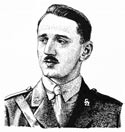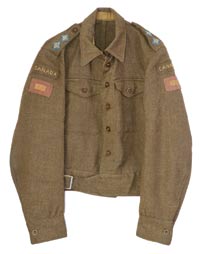Canada Remembers Times - 2009 Edition - Page 3
Profiles of Courage
One of the Best

Henry Louis Norwest, MM.
Photo:The Royal Canadian Legion Branch #29 (Worthington)
Henry Louis Norwest was one of the best snipers of the First World War, with 115 fatal shots. He earned the Military Medal for his bravery and devotion under fire during the taking of the “Pimple,” a strongly defended high point on Vimy Ridge, in April 1917. He was awarded a bar to his Military Medal the following year.
Norwest was born in Fort Saskatchewan, Alberta, a Métis of French-Cree ancestry. He worked as a ranch-hand and rodeo performer.
Three months before the end of the war, Henry Louis Norwest was killed by an enemy sniper. He is buried in the Warvillers Churchyard Extension Cemetery in Warvillers, France.
E-Mails from the Front

Captain Nichola Goddard
Photo: Department of National Defence
Canadian Forces (CF) members serving far from home have always done their best to keep in touch with family and friends. Captain Nichola Goddard, the first female CF member killed during combat duty, wrote the following e-mail to her parents from Afghanistan just weeks before her death.
May 2, 2006
Dear Mum and Dad,
The days seem to move along at their own pace. Some days fly by, and others creep along. We are officially at the halfway point now, though I can’t believe I’ve been here for three months. I try to remind myself to appreciate every experience—even the ones I don’t really enjoy. :)
I have been thinking a lot about fate lately. It was such an accident of birth that we ended up where we did when we did, that we are where we are now, with the choices that we have available to us. It seems to me that we have such a burden of responsibility to make the world a better place for those who were born into far worse circumstances. It is more than donating money to charities; it is taking action and trying to make things better. You have both shown me that throughout my life, but here I realize it more than ever before.
My current job and role in Afghanistan is part of that, but it is more the non-governmental organizations that come later. They are the ones that really make the difference. I like to think that my being here means they will be able to come that much sooner and operate more freely. I will be looking for more opportunities to volunteer in Wainwright [Alberta] and to really try to make a difference. It is very humbling to be here, part of something so much bigger than myself.
Love always,
Nichola
Brillant Refused to Quit

Lieutenant Jean Brillant, VC
Image: VAC
Jean Brillant, from Assametquaghan, Quebec, was a lieutenant with the 22nd Battalion, known after the war as the Royal 22e Régiment or affectionately named the “Vandoos.” Brillant was in action on August 8, 1918, during the Battle of Amiens.
While leading his company in two separate attacks on enemy machine-gun posts, he greatly assisted in the capture of some 150 prisoners and 16 machine guns. He was wounded in both attacks, but refused to leave his company.
During an attack on a third enemy post, Brillant was wounded a third time and died of his wounds two days later. Decorated with the Military Cross in May 1918, he was posthumously awarded the Victoria Cross in September 1918. He is buried in Villers-Bretonneux Military Cemetery, France.
Nova Scotia Hero Receives VC

William Hall, VC
Image: Library and Archives Canada
PA-008759
William Hall, who served on the British Royal Navy Ship HMS Shannon, was the first Nova Scotian, and the first black person, to receive the Victoria Cross.
In 1857, Hall was sent with a brigade of soldiers to Lucknow, India, to relieve the besieged British garrison.
As a member of one of four gun crews, Hall was attempting to break through the walls of an important enemy stronghold. Heavy enemy gunfire left only Hall and another officer alive. They continued to load and fire the last gun until the wall was broken, allowing the soldiers of the British garrison to escape.
Hall died in 1904 at his farm in Avonport, Nova Scotia. His Victoria Cross is on display at the Nova Scotia Museum in Halifax, alongside his other medals.
Connected by a Thread

Williamson’s uniform jacket with hand-sewn badges.
Photo: © A Needle Pulling Thread Magazine
In May 1944, Lieutenant George Williamson of the Royal Canadian Engineers removed his uniform before swimming across a river on a mission in Italy. Unfortunately, he was captured, and given a replacement uniform by the Red Cross at his prisoner of war camp. Military uniforms are a source of pride and identity, but his new gear did not display his rank or unit badges. Determined to keep his connection with his comrades and the outside world, he handstitched replacement identification and rank markings for his new jacket, using scrap thread and material scavenged from others in his camp.
- Date modified: